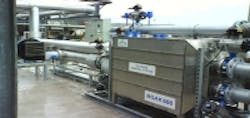UK Wastewater Biogas Siloxane Removal Specialist Acquired by Parker Hannifin
Motion and control technologies firm, Parker Hannifin, has acquired West Sussex, UK based PpTek a specialist in the provision of regenerative siloxane removal solutions for biogas produced by wastewater plants.
Following the acquisition, PpTek will become an integrated business unit within Parker’s Hiross Zander Division, which Parker said would enable it to offer a comprehensive portfolio of solutions in the biogas conditioning market.
The company explained that Volatile Methyl Siloxanes (VMS) are a class of chemicals widely used in personal care products, the dry cleaning industry and as effective cleaning agents of electronic circuitry. The waste from these products and applications is frequently ends up in wastewater treatment facilities or landfill sites.
As the waste decomposes it produces methane and carbon dioxide, a mixture of gases which is used for energy and heat generation, comparable to conventional biogas. The siloxanes blend with this gas and contaminate it.
According to Parker without an effective siloxane removal system, silicon dioxide - a chemical compound resulting from the combustion of the contaminated raw gas – combines with other elements in the gas and forms abrasive sand. This damages the internal components of the gas engine, leading to downtime and costly repair work.
The company added that for gas-to-grid or gas-to-vehicle applications, the biogas must be totally free from siloxanes contamination to avoid damage to vehicles or gas appliances.
Whilst various methods have been employed in the attempt to reduce the effect of these deposits, Parker said that the regenerative removal system devised by PpTek offers a cost-effective and environmentally friendly solution which allows engines to be run to their full potential between service intervals and overhauls.
“We can now offer our customers holistic solutions to condition their gas to be used for combined heat and power, gas-to-grid and gas-to-vehicle installations,” commented stated Guido Fogolari, general manager of Parker’s Hiross Zander Division.
